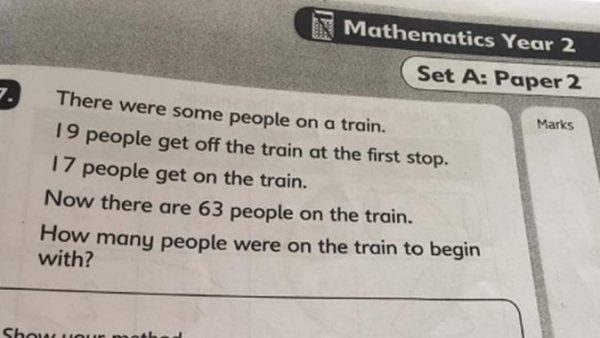At first glance, it looks easy. But it’s stumped many over the years, starting in Japan.
The problem went viral in Japan after a recent study found only 60 percent of people between the ages of 21 and 29 could get the correct answer–down from 90 percent in the 1980s.
Despite appearing simple, Presh Talwalker of Mind Your Decisions noted what had fooled most people.
“You should write an expression that groups one third as one group,” he says in the video.
“Three divided by one third is equal to nine, and now we have nine minus nine, plus one,” he added
The solution harkens back to an acronym some likely learned in school: BODMAS, or brackets, open; divide; multiply; add; and subtract, in that order.
It’s also known as PEMDAS, or parentheses first, exponents (ie powers and square roots) next, multiplication and division (left-to-right), and addition and subtraction (left-to-right).
More Math Problems
Another viral math problem is:
There were some people on a train.
19 people get off the train at the first stop.
17 people get on the train.
Now there are 63 people on the train.
How many people were there on the train to begin with?

Here’s the answer to the problem:
There are 63 people on the train, meaning that one would subtract the 17 people who boarded the train.
Then you would have to account for the 19 people who got off, and one then has to add 19 and 46.
That gives 65, the answer, meaning there were 65 people on the train to start.
Or one could subtract 19 people by 17 people, which equals 2. Then add the other 63 to 2, which equals 65.
Louise Bloxham posted the problem to Twitter, confusing a number of people by stating the answer is 46. But that only solves the first portion of the problem.
As the Metro noted, “people said that the 19 was a red herring, which doesn’t make sense, or that the train was empty to begin with, which doesn’t make sense. It even says there are ‘some people’ on the train.”
Americans Bad at Math?
It’s been noted that Americans aren’t great at math compared to other developed countries.
“Americans continually score either in the mid- or bottom-tier when it comes to math and science compared to their international peers,” says BigThink. “Students have a fundamental misunderstanding of what math is and what it can do. By viewing it as a language, students and teachers can begin to conceptualize it in easier and more practical ways.”
It says that Americans worry too much about “rote memorization,” and students have a difficult time learning the concepts in sequential order.
“Unlike the more difficult and comprehensive math tests given to test students’ comprehension, this test was for basic numeracy skills. The United States fell behind in 22nd place,” it says.







